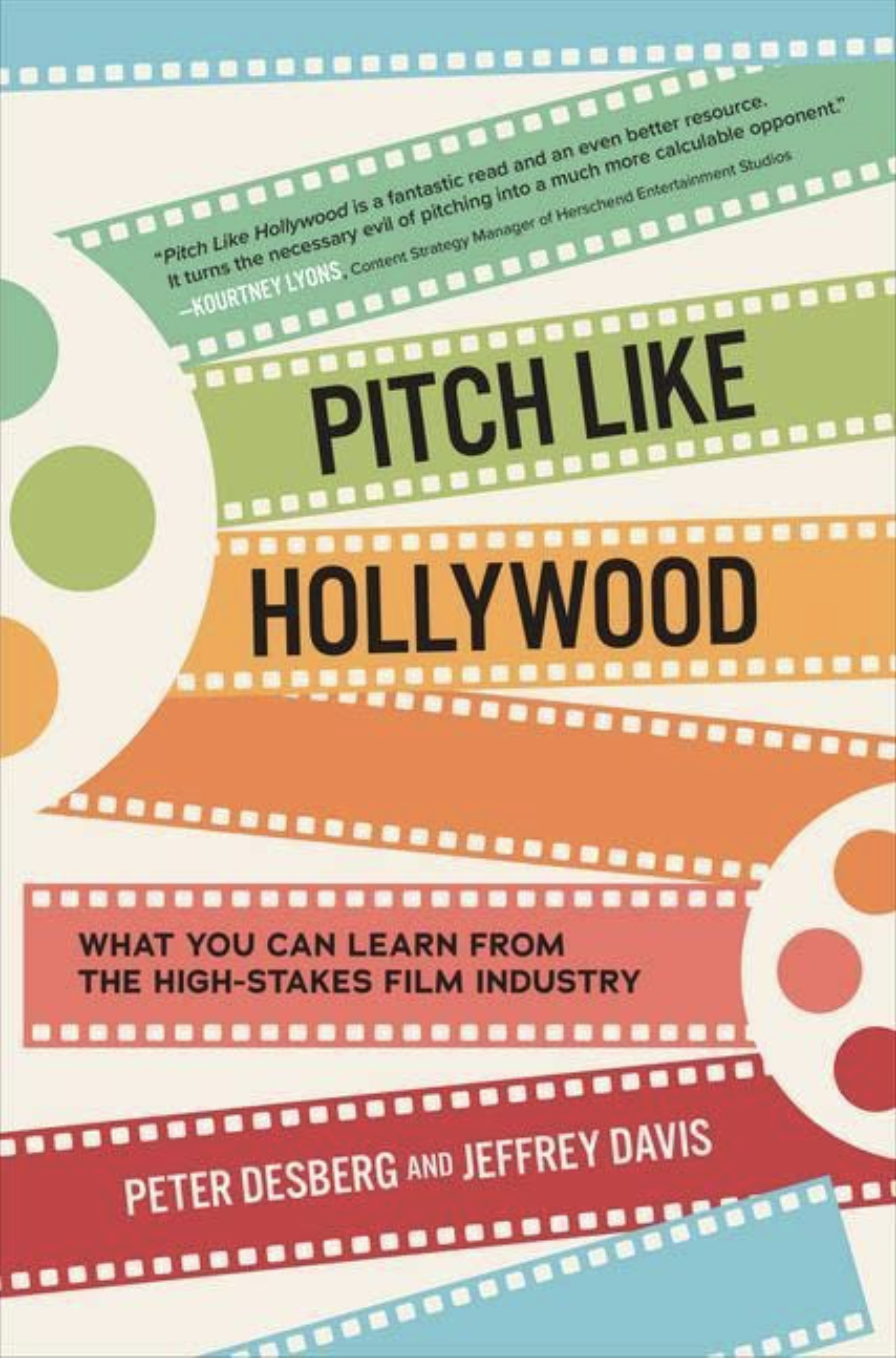

We’re pleased to welcome the co-authors of the new book, Pitch Like Hollywood: What You Can Learn from the High-Stakes Film Industry, Peter Desberg and Jeffrey Davis. Peter is a licensed clinical psychologist, and author of 23 books. He has been quoted by publications like The Wall Street Journal and Psychology Today and has consulted for companies including Apple, Boeing, and Toyota.
Jeffrey Davis is a Hollywood writer, producer, consultant, author, and professor. Jeffrey has written and produced shows for Dick Clark Productions and has more than 30 credits to his name.
Transcription:
Jim Fitzpatrick:
Thank you so much for joining us.
Jeffrey Davis:
Thank you.
Peter Desberg:
We are honored to be here.
Jim Fitzpatrick:
Great. And congratulations on the book. I heard great things about it. While I have not had an opportunity to read it yet, you can be sure I will be doing it this week. So thanks so much for that. And let me jump right in here, because I know that our audience is going to be asking here. So Peter, as I mentioned, your background as a clinical psychologist and Jeffrey, you’re a Hollywood writer and producer, how did you guys come together? And I’ll start with Peter on that.
Peter Desberg:
Well, we started a … we wrote a different book about how comedy writers do what they do. And in the course of those interviews, they kept telling us stories about pitching. And so Jeffrey came up to me one day real excited and said, hey, why don’t we do a book about pitching? We have these great stories. We’ve done this so much ourselves. And as we started getting into the book, it was going to initially be for screenwriters on how to sell their scripts.
Peter Desberg:
And we kept saying, these principles are the same for any kind of pitching. And then we consulted something that’s very close to the Bible, a Harvard Research Review that said, we’re going to do the largest scale study ever done on pitching. And we’re going to go right into the lion’s den and go into the most difficult area there is to pitch, Hollywood.
Jim Fitzpatrick:
Yeah.
Peter Desberg:
And Jeffrey and I just looked at each other and said, yep. All our instincts were there. And these principles not only are universal, but Jeffrey pointed out, very adroitly, that Hollywood has developed a way of pitching that is so far advanced because they do all the other stuff, you get all the numbers and all the stuff that you do in a pitch, but they’ve added curiosity and emotion to a pitch.
Jim Fitzpatrick:
Yeah. That’s right.
Peter Desberg:
They’re the things that keep you listening. And as Jeffrey will always tell you, you want to pitch where they’re saying, what happens next? Rather than, when will this thing be over?
Jim Fitzpatrick:
Right. Right. We’re all very curious about the next step aren’t we, Jeffrey?
Jeffrey Davis:
Yes. And so what we’ve done in the book is take the methods … and we use a academic word, the methodology of the Hollywood pitch. Because what we discovered in all of the interviews that we did with people in business, from Toyota to Boeing and back, is there’s a lot of slideshows, lots of PowerPoint, lot of statistics, but no story. So what the book adds is the element of the story, combined with the other two things we don’t think have been in books on pitching. One is the science of persuasion, and the other is how not to get stage fright. And Peter happens to be an expert on that. That’s his area of expertise, is how to prevent stage fright.
Jim Fitzpatrick:
Sure, sure. So, Peter, what are the most important elements of a pitch?
Peter Desberg:
Oh, that’s a great question. I’m going to answer this in two different ways, because the way we approached it is the person doing the pitch, what are the things they have to go through? And the thing that we noticed is preparation is the absolute key. If you don’t prepare adequately for the pitch, you can skunk yourself right away. And the reason for this in part …there’s a wonderful book that I will tout, even though we don’t make a penny from the book. It’s Daniel Kahneman’s book, Thinking Fast and Slow. I don’t know if you’re familiar with it, but it’s the most brilliant book written in the last 30 years.
Peter Desberg:
And among other things, what he talks about a lot in there is there are two ways of thinking. Mostly we use our intuition, but if we’re forced to really think hard, then we have to slog through that. But we don’t like to do that. And he does a tremendous amount of research showing that when you ask somebody, hey, when you have a tough problem, do you think hard and deep? And everybody says, oh yeah. But then he looks at the evidence and says, uh-huh (affirmative).
Peter Desberg:
Now, intuition sounds very flighty, but really it’s everything you know, everything you believe, every bias you hold onto. It’s pretty powerful stuff. And so what you learn is, if you are not pitching to somebody in accordance with their beliefs, what they know to be true and what they feel in their hearts, you immediately change their mood to, A, you’re putting them in a bad mood because they have to use their brains and think really hard. Plus, there’s a red light that goes off that makes them really skeptical and want to question everything you do because you’re going against their very core.
Peter Desberg:
And so it’s very essential to find out everything these people believe, everything that they’ve done to keep what you’re doing in accordance with that. And to offer the according to that.
Jim Fitzpatrick:
Do you find that when you’re pitching, especially today, when people have got their iPhones and their laptops and their tablets accessible to them, and right down to their wristwatches, talking to them or ringing or what have you, everybody’s attention span seems to be seconds, not even minutes anymore. Talk to us about that, and how pitching today has got to be almost in just a few moments rather than …
Jeffrey Davis:
Well, we know that the first … the two minutes before and the two minutes after you start are the most important. So you’ve got to get them then. And we also know that the best way to handle this, and this is really Peter’s area of expertise, is to practice, practice, practice. Do not come in and try to wing it, because there are all these distractions. But the interesting thing is, there’ve always been distractions. The best way to handle distractions is to practice. And as Peter always says, practice in the conditions as close to what you will be doing and the situation you’ll be in.
Jim Fitzpatrick:
Good point.
Jeffrey Davis:
Practice with people coming in and distracting you. Rehearse, in other words.
Jim Fitzpatrick:
Right.
Jeffrey Davis:
And I think this is a problem that’s only going … and we thought Zoom would solve that. But I can tell you, teaching on Zoom for almost two years because of the pandemic, it’s no easier.
Jim Fitzpatrick:
How do you recommend … you touched on it already a little bit. But how do you recommend that people prepare for a pitch? Because you both mentioned and put an emphasis on really being prepared before you go into a pitch. And I agree with you. I’ve pitched myself, and I know walking out going, wow, I should have prepared better. And the times that I took the time and I did spend the necessary time, I felt better. I felt more confident when I was pitching, I had all of my content lined up. I had all of my prepared answers to the frequently asked questions. But on the times that I didn’t prepare, I didn’t even deserve to get the pitch, right?
Jeffrey Davis:
Well, I think we’ve all been there. I think, just to go back to what Peter was talking about, and that is state dependent learning. So that means … and Peter, you add to this because I’m an amateur in this. He’s the pro. But state dependent learning basically means that you practice as close to the situation you will be in. So what I do with my students when we teach, particularly the graduate students because they’re going out into the industry and having careers, is get them to practice with their friends in a group. And get the friends to do all of the things that will happen in the pitch.
Jeffrey Davis:
Then again, go back to the homework, do your homework on the person you’re pitching to. Absolutely. And we have a little thing in the book, which is the … what’s the name of the … we call it the Bolero Blunder. Peter, tell him about the Bolero Blunder, because I think it’s a great story. And I can say that because it wasn’t mine. It was Peters.
Peter Desberg:
Okay. So we’ll we harken back to preparation. You certainly want to know the people’s history. What projects have they been in favor of? How to work out, et cetera, et cetera. What you want to do is not just learn everything that they’ve done, but which things they’re proud of and which things they aren’t. A good example, a friend of ours is a producer, and he produced a movie years ago called, The Burbs. Well, he had a big fight with the studio, and he said, the hero has to die at the end. The studio came back and said, we’re not killing Tom Hanks. He’s going to make it to the end. And so they forced him to use their ending. He didn’t go to the premier. If you mention that movie to him, he wants to punch you in the face.
Jim Fitzpatrick:
Wow. That’s very interesting.
Peter Desberg:
So if you did your cursory preparation and said, oh, you’re the guy that produced The Burbs. Congratulations. You’re marching toward the door. So you have to know. And the term that Jeffrey came up with, the Bolero Blunder, is Maurice Ravel wrote a piece called Bolero. It’s the most famous piece he ever wrote. And he thought it was a mediocre piece at best, and throughout his life was bitter about the fact that’s what he’s known for.
Jim Fitzpatrick:
Wow. [crosstalk 00:11:40].
Peter Desberg:
So again, going after somebody for something that they don’t consider good …
Jim Fitzpatrick:
That’s right. [crosstalk 00:11:47] That’s an expensive lesson.
Peter Desberg:
It can hurt you more than never having said anything at all.
Jim Fitzpatrick:
That’s right.
Peter Desberg:
Back to your bigger question about preparation. So obviously, a big part of this is how you prepare the pitch itself. Taking the results of all your research, trying to, again, Jeffrey’s saying, make it a conversation. You don’t want to be pushing yourself on these people. So you’re always framing it from their point of view. How is this going to help you rather than, let me tell you why this will make me rich.
Jim Fitzpatrick:
Right. Right. Right.
Peter Desberg:
So now you’ve got your pitch. The next thing is practicing it. And again, as Jeffrey was mentioning, state dependent learning, there’s a tremendous amount of research that we cite on practice the way you’re going to perform. So for example, a great way to do this is get a bunch of really sophisticated colleagues, and help each other pitch. Pitch to them. And don’t just have them sit there and listen, have them interact with you. And practice.
Peter Desberg:
In other words, say to them, okay. You’re an acerbic person anyway. Do me a favor, every once in a while, bust in and challenge me. Harass me. Because I want to become Bulletproof, so no matter what happens in the room, I’ll be ready. Practice with distractions. Cell phones are going to go off. Secretaries are going to come in to interrupt, all this stuff, practice all that so that your bullet proof.
Jim Fitzpatrick:
Yep. Yep. That’s that’s a very good point. Very good point. What’s the best way to close a pitch?
Jeffrey Davis:
Oh. Always, thank you for letting us come.
Jim Fitzpatrick:
Thank you for letting us come.
Peter Desberg:
Thank you for buying the project. That’s the best way.
Jim Fitzpatrick:
Exactly.
Peter Desberg:
But you don’t always get that.
Jim Fitzpatrick:
No.
Jeffrey Davis:
I think that in my experience, you want one of two things. If you didn’t sell it, then you want them to ask you back. And that has happened to both of us. Separately and together. And the other thing is you want to leave them wanting to know more.
Jim Fitzpatrick:
Okay.
Jeffrey Davis:
Because in Hollywood, if you do the initial pitch … and it was successful. They’re going to ask you to come back with a developed pitch. That’s going to be hours, probably. And then in business, that’s the sales plan. That’s the business plan. But If you don’t have that initial meeting, which again is the conversation, you’re already dead.
Jim Fitzpatrick:
And I think everyone it seems that I know, that I’ve been in that situation, where I always think time is of the essence. You want to get in, you want to get going. You think that these people want to get right to the bottom line. What’s it going to cost us, or what’s it going to make us, one way or the other. And you can’t wait to get there and you just want to deliver it and then look for that close or that approval or that next step, or what have you.
Jim Fitzpatrick:
And to your point, Jeffrey, that is important. And I’ve been in rooms where I’ve been sitting at the conference table listening to pitches. And I agree that I would like to know about the individual a little bit more. What’s their career path? What’s their background? Do they have kids, do they not? Are they married, are they not? Have they been living in the area long? What’s the deal. So maybe that’s the right way to start the pitch, right? Tell a little bit about yourself.
Peter Desberg:
Well, they’re going to ask you. And one of the things we talked about is you have to have several different kinds of openings. Because sometimes it’s, okay, time is money. What do you got for today? All the way to, tell us about yourself, or what have you been working on? You have to practice all of those. But an important point that our friend Jen Grisanti made is, when you tell a personal story, put some thought into it. And make sure that somehow what you’re weaving in is why you’re the right person for this pitch, in your story.
Jim Fitzpatrick:
Okay. Yeah, it makes sense.
Peter Desberg:
So it could be related to where you’re going to go.
Jim Fitzpatrick:
The book is Pitch Like Hollywood, and you can find that book just by clicking the link below, right below this interview. Gentlemen, want to thank you so much for joining us on the show today. Mr. Peter Desberg and Jeffrey Davis. Thanks so much for joining us.
Peter Desberg:
Thank you.
Jeffrey Davis:
Thank you, Jim.
Peter Desberg:
You’ve been so, so good. You asked all the right questions.
Jim Fitzpatrick:
That’s fantastic. And I want to keep a smile on my face to keep you guys happy with me, so that I win the pitch.
Peter Desberg:
You asked the few questions we actually knew the answers to. So we appreciate that.
Jeffrey Davis:
You absolutely sold us. Thank you [crosstalk 00:16:37].
Jim Fitzpatrick:
I did my research before coming on today.
Peter Desberg:
Thank you very, very much.
Jeffrey Davis:
Thank you, Jim.
Jim Fitzpatrick:
Thanks so much guys. All right. Stay well.
The Atlanta Small Business Network, from start-up to success, we are your go-to resource for small business news, expert advice, information, and event coverage.
While you’re here, don’t forget to subscribe to our email newsletter for all the latest business news know-how from Atlanta Small Business Network.







